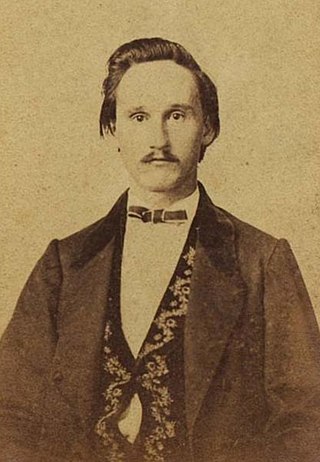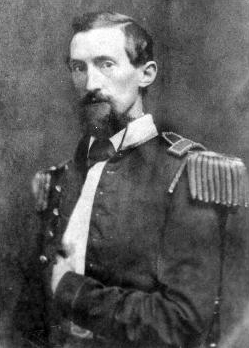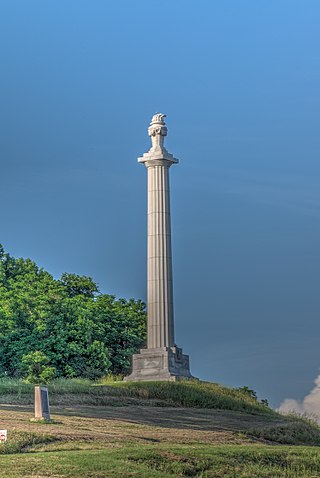The Battle of Plains Store was fought on May 21, 1863, in East Baton Rouge Parish, Louisiana, during the campaign to capture Port Hudson in the American Civil War. Union troops advancing from Baton Rouge, Louisiana, clashed with 600 Confederates at a road junction. The initial Confederate force withdrew, but 400 more Confederates arrived from Port Hudson. Some of the Confederate reinforcement overran Union artillery and routed a Union regiment, but were unable to capture the guns. Union reinforcements advanced to the front, attacked part of the Confederate force and drove them from the field. The Confederates withdrew to Port Hudson, which was almost entirely surrounded by Union troops the next day. Port Hudson was under siege until the defenders surrendered on July 9.
The 26th Indiana Volunteer Infantry Regiment was an infantry regiment that served in the Union Army during the American Civil War.

The 9th Louisiana Cavalry Regiment, also known as Ogden's Cavalry, was a Confederate unit in the American Civil War. The unit was commanded by Colonel Frederick Nash Ogden. Although the unit was called a cavalry regiment, it was more properly classified as a mounted infantry unit.
The Pointe Coupee Artillery was a Confederate Louisiana artillery unit in the American Civil War made up primarily of men from the parishes of Pointe Coupee, East Baton Rouge, Livingston and other surrounding parishes as well as a large number of men from New Orleans.
The 41st Regiment Massachusetts Volunteer Infantry was a three-year infantry regiment that served in the Union Army during the American Civil War. It was recruited as part of Governors Banks' and Andrew's recruitment drives to supply the union with a military force to hold and expand Union control of the lower Mississippi. In the late winter/early spring of 1863, it was converted to mounted infantry and later to cavalry. On its conversion in June 1863 at Port Hudson, it was disestablished and re-established as the 3rd Massachusetts Volunteer Cavalry.
The 2nd Louisiana Infantry Regiment, also known after September 1863 as the 2nd Louisiana (US) Mounted Infantry, was a unit in the Union Army during the American Civil War. The regiment served in the Union Army XIX Corps in Louisiana throughout the war.

The 10th Arkansas Infantry (1861–1865) was a Confederate Army infantry regiment during the American Civil War from the state of Arkansas. The unit is also known as A. R. Witt's Infantry, C. M. Cargile's Infantry, E. L. Vaughan's Infantry, Thomas D. Merrick's Infantry, S. S. Ford's Infantry, Obed Patty's Infantry, George A. Merrick's Infantry, Zebulon Venable's Infantry and Robert C. Bertrand's Infantry in contemporary accounts. After being captured at the Siege of Port Hudson, the unit reorganized as a mounted infantry unit, and was known as the 10th Arkansas Cavalry Regiment or Witt's Arkansas Cavalry.
The 11th/17th Consolidated Arkansas Infantry (1861–1865) was a Confederate Army infantry regiment during the American Civil War. The unit is also known as the 11th/17th Arkansas Mounted Infantry or the 11th/17th Arkansas Cavalry. At various times after the consolidation, members of the unit who were captured gave their unit as either the 11th Arkansas Cavalry or the 17th Arkansas Cavalry.
Witt's 10th Arkansas Cavalry (1863–1865) was a Confederate Army Cavalry regiment during the American Civil War from the state of Arkansas. The unit was originally known as the 10th Arkansas Infantry Regiment, but was converted to cavalry after being exchanged following the fall of Port Hudson, La.
The 3rd Massachusetts Volunteer Cavalry Regiment was a cavalry regiment that served in the Union Army during the American Civil War. It was organized by consolidating the 41st Massachusetts Mounted Infantry and the 2nd Battalion Massachusetts Cavalry on June 17, 1863. The regiment served with the XIX Corps, Army of the Gulf during the Red River Campaign in 1864. Its heaviest combat during this campaign took place during the Battle of Sabine Crossroads.

The 49th Regiment Massachusetts Volunteer Infantry was a regiment of infantry that served in the Union Army during the American Civil War. It was one of the 18 Massachusetts regiments formed in response to President Abraham Lincoln's August 1862 call for 300,000 men to serve for nine months. The regiment was recruited in Berkshire County and rendezvoused for mustering in at Camp Briggs in Pittsfield, Massachusetts. William F. Bartlett, a veteran of the 20th Massachusetts was voted colonel in command of the regiment. The 49th Massachusetts was assigned to the Department of the Gulf and saw heavy combat during the Siege of Port Hudson.

The 2nd Louisiana Cavalry Regiment was a unit of mounted volunteers recruited in Louisiana that fought in the Confederate States Army during the American Civil War. Breazeale's Cavalry Battalion was formed in July 1862 and was augmented by five additional companies in September 1862 to form a regiment. It served for the entire war west of the Mississippi River in the Trans-Mississippi Department. The regiment fought at Georgia Landing, Fort Bisland, Irish Bend, and Brashear City in 1863 and Henderson's Hill and Mansfield in 1864. Afterward, the regiment fought in minor skirmishes before the Trans-Mississippi's final surrender on 26 May 1865.

The 12th Louisiana Infantry Regiment was a unit of volunteers recruited in Louisiana that fought in the Confederate States Army during the American Civil War. Formed in August 1861, the regiment served in the Western Theater of the American Civil War and was unique in that there were 12 companies. The regiment garrisoned Island Number Ten before being stationed at Fort Pillow. It fought at Second Corinth in 1862 and Champion Hill and Jackson in 1863. A detachment served during the Siege of Vicksburg and was captured. In 1864, the regiment fought in the Meridian, Atlanta, and Franklin–Nashville campaigns, suffering heavy losses at Peachtree Creek and Franklin. It fought at Bentonville in 1865 before surrendering with General Joseph E. Johnston.

The 4th Louisiana Infantry Regiment was a unit of volunteers recruited in Louisiana that fought in the Confederate States Army during the American Civil War. Formed in May 1861, the regiment served in the Western Theater of the American Civil War. The unit fought at Shiloh and Baton Rouge in 1862 and at Jackson in 1863. A detachment served during the Siege of Port Hudson and was captured. In 1864, the regiment fought in the Atlanta campaign where it lost heavily at Jonesborough. At Nashville in December 1864 most of the men were captured. The survivors were consolidated with several other units and fought at Spanish Fort in April 1865. The remnant surrendered in May 1865.

The 18th Louisiana Infantry Regiment was a unit of volunteers recruited in Louisiana that fought in the Confederate States Army during the American Civil War. The regiment began forming in October 1861, but did not reach its full complement of 10 companies until January 1862. It served throughout the war in the Western Theater of the American Civil War. In 1862, the regiment served at Shiloh, First Corinth and Georgia Landing (Labadieville). In 1863, it fought at Fort Bisland and campaigned in south Louisiana. In November 1863, the unit merged with the 10th Louisiana Infantry Battalion, creating the 18th Consolidated Louisiana Infantry Regiment. The new regiment served during the Red River campaign in 1864, fighting at Mansfield, Pleasant Hill, and Yellow Bayou. The regiment remained in Louisiana and Arkansas for the rest of the war, before disbanding in May 1865.

The 27th Louisiana Infantry Regiment was a unit of volunteers recruited in Louisiana that fought in the Confederate States Army during the American Civil War. The regiment formed in April 1862 at Camp Moore and served during the war in the Western Theater of the American Civil War. On 1 May 1862, the regiment marched to Mississippi and defended Vicksburg. The regiment suffered heavy losses, including both its colonel and lieutenant colonel killed, while defending the city during the Siege of Vicksburg. The survivors were captured when Vicksburg fell, were paroled, and went home. The regiment was declared exchanged in fall 1863, but many soldiers failed to report for duty. Two companies joined Gober's Louisiana Mounted Infantry Regiment, but most of the men spent the rest of the war near Pineville, Louisiana, on garrison duty, and disbanded in April and May 1865.

The 23rd Louisiana Infantry Regiment was a unit of volunteers recruited in Louisiana that fought in the Confederate States Army during the American Civil War. The regiment organized in January 1862 at New Orleans by merging the Orleans Artillery Battalion, a state militia unit, with six independent companies. In March 1862, the unit mustered into Confederate service with 841 men and served during the war in the Western Theater of the American Civil War. The various companies were allocated to defend various forts. One company was assigned to hold Fort Jackson, fought in the Battle of Forts Jackson and St. Philip, and surrendered when the fort fell. After the Capture of New Orleans most of the companies disbanded. However, four companies reorganized at Camp Moore in May 1862 and traveled to Vicksburg, Mississippi where they manned the river batteries. In early 1863, the regiment was renamed the 22nd Louisiana Infantry Regiment. The soldiers went to Fort Pemberton where they helped drive off the Yazoo Pass expedition. The regiment was part of the garrison during the Siege of Vicksburg and was captured and paroled when the city fell in July 1863. The men reported to a parole camp. In January 1864, it and the remnants of six other Louisiana regiments were absorbed into the 22nd Consolidated Louisiana Infantry Regiment. This unit fought at Spanish Fort in March and April 1865 and surrendered at Meridian, Mississippi in May 1865.

The 31st Louisiana Infantry Regiment was a unit of volunteers recruited in Louisiana that fought in the Confederate States Army during the American Civil War. The unit began its existence as Morrison's Battalion on 14 May 1862. The regiment organized at Monroe, Louisiana, on 11 June, after which it moved to Madison Parish, Louisiana, near Vicksburg, Mississippi. The unit stayed near Tallulah and Delhi until November, when it was ordered to Jackson, Mississippi. There, the Catahoula Battalion joined the regiment, bringing it up to ten companies. In December 1862, the regiment fought at Chickasaw Bayou. After remaining near Vicksburg in the early part of the year, it fought at Port Gibson on 1 May 1863. During the Siege of Vicksburg, the soldiers defended the city, surrendered when the place fell, and were paroled. When the regiment was exchanged in June 1864, many of the men chose to remain at home. The soldiers who returned to duty eventually marched to Pineville, which they guarded until February 1865. At that time, the regiment marched to Bayou Cotile. The unit disbanded in May 1865.

The 30th Louisiana Infantry Regiment was a unit of volunteers recruited in Louisiana that fought in the Confederate States Army during the American Civil War. On 17 December 1861, the Sumter Regiment was accepted into state service at New Orleans. On 1 March 1862, the militia regiment transferred to Confederate service for a 90-day enlistment. At the Capture of New Orleans on 25 April, three and a half companies stayed in the city and were captured. The other companies went to Camp Moore where the regiment reorganized for Confederate service on 15 May 1862, by the addition of four more companies. Company K left on furlough and never returned. The regiment fought at Baton Rouge before being assigned to garrison Port Hudson. On 4 March 1863, two companies were suppressed and their men reassigned to other companies, officially reducing the regiment to a 7-company unit named the 30th Louisiana Infantry Battalion. However, contemporary records often continued to refer to the unit as a regiment. A detachment was captured at the Siege of Port Hudson, but the bulk of the battalion served at Jackson in 1863, and New Hope Church, Atlanta, Ezra Church, and Nashville in 1864. The survivors were consolidated with the remnants of the 4th and 13th Louisiana Infantry Regiments, and the 14th Louisiana Battalion in February 1864. The men fought at Spanish Fort in March and April 1865, and surrendered in May 1865.

The 24th Louisiana Infantry Regiment was a unit of volunteers recruited in Louisiana that fought in the Confederate States Army during the American Civil War. The Crescent Regiment, a state militia unit, transferred to Confederate service at New Orleans in March 1862 for a 90-day enlistment. The regiment immediately traveled to join the Confederaste army at Corinth, Mississippi, and fought at Shiloh and First Corinth. The regiment disbanded in June at the end of its term of service, most of the men joining the 18th Louisiana Infantry Regiment. The regiment was revived at New Iberia, Louisiana, in September 1862, where it was rejoined by the men in the 18th Louisiana. It fought at Georgia Landing (Labadieville) in October 1862 and at Fort Bisland in April 1863. In November 1863 at Simmesport, the regiment merged with the 11th and 12th Louisiana Infantry Battalions, becoming the Consolidated Crescent Regiment. The new regiment fought at Mansfield, Pleasant Hill, and Yellow Bayou in April and May 1864. At Mansfield, all three field officers were fatalities and 175 soldiers became casualties. The regiment spent the rest of the war in Arkansas and Louisiana before disbanding in May 1865.












